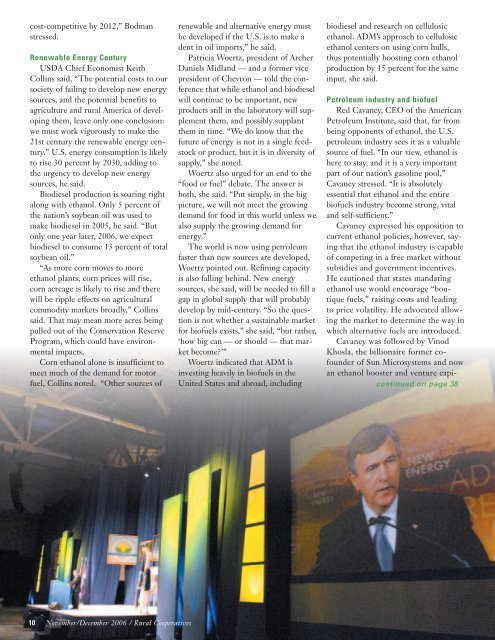How bike co-op went off track - USDA Rural Development - US ...
How bike co-op went off track - USDA Rural Development - US ...
How bike co-op went off track - USDA Rural Development - US ...
Create successful ePaper yourself
Turn your PDF publications into a flip-book with our unique Google optimized e-Paper software.
<strong>co</strong>st-<strong>co</strong>mpetitive by 2012,” Bodman<br />
stressed.<br />
Renewable Energy Century<br />
<strong><strong>US</strong>DA</strong> Chief E<strong>co</strong>nomist Keith<br />
Collins said, “The potential <strong>co</strong>sts to our<br />
society of failing to devel<strong>op</strong> new energy<br />
sources, and the potential benefits to<br />
agriculture and rural America of devel<strong>op</strong>ing<br />
them, leave only one <strong>co</strong>nclusion:<br />
we must work vigorously to make the<br />
21st century the renewable energy century.”<br />
U.S. energy <strong>co</strong>nsumption is likely<br />
to rise 30 percent by 2030, adding to<br />
the urgency to devel<strong>op</strong> new energy<br />
sources, he said.<br />
Biodiesel production is soaring right<br />
along with ethanol. Only 5 percent of<br />
the nation’s soybean oil was used to<br />
make biodiesel in 2005, he said. “But<br />
only one year later, 2006, we expect<br />
biodiesel to <strong>co</strong>nsume 13 percent of total<br />
soybean oil.”<br />
“As more <strong>co</strong>rn moves to more<br />
ethanol plants, <strong>co</strong>rn prices will rise,<br />
<strong>co</strong>rn acreage is likely to rise and there<br />
will be ripple effects on agricultural<br />
<strong>co</strong>mmodity markets broadly,” Collins<br />
said. That may mean more acres being<br />
pulled out of the Conservation Reserve<br />
Program, which <strong>co</strong>uld have environmental<br />
impacts.<br />
Corn ethanol alone is insufficient to<br />
meet much of the demand for motor<br />
fuel, Collins noted. “Other sources of<br />
10 November/December 2006 / <strong>Rural</strong> Co<strong>op</strong>eratives<br />
renewable and alternative energy must<br />
be devel<strong>op</strong>ed if the U.S. is to make a<br />
dent in oil imports,” he said.<br />
Patricia Woertz, president of Archer<br />
Daniels Midland — and a former vice<br />
president of Chevron — told the <strong>co</strong>nference<br />
that while ethanol and biodiesel<br />
will <strong>co</strong>ntinue to be important, new<br />
products still in the laboratory will supplement<br />
them, and possibly supplant<br />
them in time. “We do know that the<br />
future of energy is not in a single feedstock<br />
or product, but it is in diversity of<br />
supply,” she noted.<br />
Woertz also urged for an end to the<br />
“food or fuel” debate. The answer is<br />
both, she said. “Put simply, in the big<br />
picture, we will not meet the growing<br />
demand for food in this world unless we<br />
also supply the growing demand for<br />
energy.”<br />
The world is now using petroleum<br />
faster than new sources are devel<strong>op</strong>ed,<br />
Woertz pointed out. Refining capacity<br />
is also falling behind. New energy<br />
sources, she said, will be needed to fill a<br />
gap in global supply that will probably<br />
devel<strong>op</strong> by mid-century. “So the question<br />
is not whether a sustainable market<br />
for biofuels exists,” she said, “but rather,<br />
‘how big can — or should — that market<br />
be<strong>co</strong>me?’”<br />
Woertz indicated that ADM is<br />
investing heavily in biofuels in the<br />
United States and abroad, including<br />
biodiesel and research on cellulosic<br />
ethanol. ADM’s approach to cellulosic<br />
ethanol centers on using <strong>co</strong>rn hulls,<br />
thus potentially boosting <strong>co</strong>rn ethanol<br />
production by 15 percent for the same<br />
input, she said.<br />
Petroleum industry and biofuel<br />
Red Cavaney, CEO of the American<br />
Petroleum Institute, said that, far from<br />
being <strong>op</strong>ponents of ethanol, the U.S.<br />
petroleum industry sees it as a valuable<br />
source of fuel. “In our view, ethanol is<br />
here to stay, and it is a very important<br />
part of our nation’s gasoline pool,”<br />
Cavaney stressed. “It is absolutely<br />
essential that ethanol and the entire<br />
biofuels industry be<strong>co</strong>me strong, vital<br />
and self-sufficient.”<br />
Cavaney expressed his <strong>op</strong>position to<br />
current ethanol policies, however, saying<br />
that the ethanol industry is capable<br />
of <strong>co</strong>mpeting in a free market without<br />
subsidies and government incentives.<br />
He cautioned that states mandating<br />
ethanol use would en<strong>co</strong>urage “boutique<br />
fuels,” raising <strong>co</strong>sts and leading<br />
to price volatility. He advocated allowing<br />
the market to determine the way in<br />
which alternative fuels are introduced.<br />
Cavaney was followed by Vinod<br />
Khosla, the billionaire former <strong>co</strong>founder<br />
of Sun Microsystems and now<br />
an ethanol booster and venture capi<strong>co</strong>ntinued<br />
on page 38

















